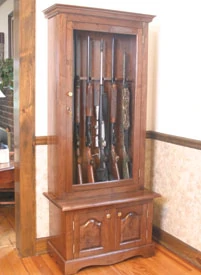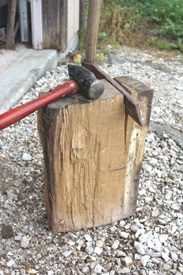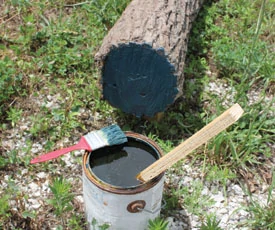By Monte Burch
Hidden treasures in overlooked places can provide the right wood at the right price for your next project.
My dad ran a custom cabinet and furniture building shop for many years, and I worked for him as a youngster during the summers, as well as full-time years later. Dad was always looking for ways of recycling wood. One job I had was tearing out the maple backstops at a local bowling alley. We ran the boards through a planer, cut them into 1-1/2-inch wide strips and glued the strips back together to create “butcher-block” kitchen countertops. Dad was ahead of his time 50 years ago, and the countertops were really popular. Then there were the old church pews he bought from a church renovation. We made furniture for years from the beautiful walnut wood.

When my pastors daughter asked me to haul off an ancient broken pew from her church, I just had to remove some paint. Guess what? Walnut. About 150 years old, the pew was held together with hand-cut nails. I disassembled the pew, planed the walnut and created a large, lighted cross for the church, along with a sample of the pew seat board, complete with bubblegum.
Reclaiming or recycling wood not only saves money on woodworking projects, but often results in finding more beautiful wood than you can purchase (or afford to purchase) today. Hardwoods, such as walnut, maple and oak were often used in relatively small projects, as well as in building construction. Our 150 year old house is framed in red oak. I discovered an old, timber-framed barn made entirely of walnut. The recycled pew had a walnut seat board, walnut trim and a back board of white pine. The back board was one piece, one-inch thick by 20 inches in width and 10 feet long. You won’t find that at your local wood dealer. Other recycling “finds” include: hickory, yellow pine, butternut, beech, maple, cherry, mahogany and chestnut. Even if some of these pieces aren’t big enough for furniture or cabinetry, they will create beautiful wood turnings or small projects.

Locating
Finding recyclable woods is like a treasure hunt. Look for renovating and remodeling jobs, particularly in older neighborhoods. Even commercial buildings often were framed of now-hard-to-get woods. Homes built during the post-depression period, however, tend to be made of less valuable woods. Old barns were once a great source of wood for recycling, but are getting harder to find. Due to insurance problems, permission to acquire woods from remodeling and renovating jobs is also getting harder. Most owners don’t want you taking just a few boards, so it’s a good idea to make friends with a renovator. Of particular interest are the interiors and trim, especially from public buildings and churches. Even something as hum-drum as shelving boards can be valuable, if made of a quality wood.

Discarded furniture often results in great finds. Don’t expect an “Antique Road Show” find, but garage sales, going-out-of business sales and even the community clean-up days can result in haul-it-away furniture with recyclable woods. You’ll often discover, as I did, a beautiful and useful wood under coats of paint. Even an ugly piece of furniture may have some redeeming woods. Avoid veneered projects as veneer rarely covers great woods.

Another source is wood pallets. Pallets are readily available and many companies will gladly let you take them. These can vary from great finds to only firewood quality. Heavier equipment is usually shipped on hardwood pallets. Heavy-duty pallets holding imported products can also be good, because cheap woods in one country may be valuable in another. I’ve often found valuable, thin plywood used with many heavy-machine crates. This makes great cabinet backing and craft projects. On the other hand, softwood pallets aren’t usually worth the effort. Do not use pallets that may have contained toxic materials such as paints, chemicals and so forth.
If you’re looking for small pieces of wood for wood turnings, making small boxes and so forth, check the local yellow pages for cabinetmakers, boat builders, millwork plants and others. You may be able to acquire their off-cut pieces for a small fee. Do not attempt to reclaim woods that are rotten or have potential insect problems. Doing so can potentially bring insects such as wood beetles, wood roaches and even termites into your shop or home.


Reclaiming
The first step is dismantling. This can be easy or difficult depending on the project, the type of wood used and the intended use. Use a sharp knife, chisel or sander to remove a bit of paint or finish to determine the wood used. A great lesson I learned from years of dismantling in my dad’s shop was how furniture was put together. This made for easier restoration of valuable pieces, as well as a better idea of how to build furniture. It’s important to dismantle with a plan in order to retain as much valuable wood as possible. A big sledge-hammer is not the answer. Remove all fasteners, screws and nails as they can quickly ruin a saw, planer or jointer blade. Scanning the wood with a small woodworker’s metal detector, such as the Zircon, can save valuable blades.

Next prepare the wood for use. Grit and dirt can also dull woodworking tools. Use a stiff-bristle brush to scrub off all dirt, grit and grime. Do not use a steel or metal brush as these can leave particles in the wood surface. Don’t immediately run the wood through your saw, jointer or planer as old hardened varnish and paint can also dull and chip blades. Use a belt or drum sander to remove the old finish or paint. Make sure you wear a dust mask.

Green wood is another source for reclaiming economical wood, and I’ve also done a lot of that. A friend from Mississippi related the tremendous amount of storm-damaged pecan and other valuable trees piled and burned during the Katrina disaster. Storm-damaged trees can be a valuable wood source, as can dead or damaged trees that must be removed from yards, trees removed for developments and even the tree tops left from logging operations. Milling slabs from a saw mill can sometimes result in usable woods as well. Even short chunks usually relegated to the firewood pile can be used by wood turners. I always look for unusual grain, crotch figures and other beautiful woods, even when cutting firewood.


Many trees that would not be utilized by commercial loggers can also result in excellent material for the serious woodworker. If you have a mid-sized chainsaw and are handy with it, you can saw your own logs ready for milling.


Milling
You can cut or mill lumber if you have the right tools, some of which you may already have in your shop. The old timers cut logs into sections by “riving” or using a large chisel, wedges or a “froe” to split the wood apart. This can be used to make rough cuts, followed by a large hand plane to smooth and shape the lumber. Or, use a bandsaw to resaw the wood into planks or blocks. You will need to utilize a wide resaw blade for this chore.

A chainsaw mill is a tool that can be used by the occasional woodworking “logger” to saw small trees into planks and “blanks.” These handheld mill attachments are fastened to a chainsaw bar for slabbing and milling. The Granberg models are excellent choices and include the Alaskan MK III Saw Mill, which can be mounted on bars from 24 to 56 inches, as well as the Alaskan Small Log Milling Attachment, which can be mounted on saw bars 20-inches or less. These saws are also excellent choices for cutting beams for constructing buildings. The units require the use of a ripping chain and a chain saw of at least 50cc.

A bandsaw mill is the ultimate tool for the serious wood collector. You can saw large or small logs into boards and turning blanks. I once had a big, round-blade mill, which ran off my tractor’s power-take-off, but I’ve used a Timber King portable bandsaw mill for a number of years. It’s easier to use, wastes less wood and is portable. Some small bandmills, such as the Wood-Mizer, are extremely portable, relatively inexpensive and can even be stored in your garage when not in use.


Freshly sawn wood is green or uncured but can be used for some projects and construction. Barns, outbuildings and even post-and-beam buildings are often constructed of fresh-cut beams and posts. A favorite project of woodturners is turning green wood bowls. The wood is extremely easy to turn and provides an unusual project. Short chunks of 12 inches or less are commonly used. Use a chainsaw to saw the logs into lengths. If you’re not going to use immediately, coat both ends heavily with several coats of exterior house paint. Rough-cut the wood to shape on a bandsaw before turning.

Most woodworking projects, however, are made from dried wood. Purchased lumber is kiln-dried, but the old-time method is air drying. I’ve used this method for many years with lots of successful projects. It takes time and the appropriate space; a dry area with good air flow. You can air-dry outside, covering the wood, or you can air-dry inside. I’ve air-dried in my barn for many years.


Regardless of whether inside or outside, the boards should have their ends coated with house paint. The wood stack must also be located well off the ground or floor and supported to prevent sagging. To allow for air circulation, 3/4-inch wood stickers are placed between the planks as they are stacked in place. If drying outside, add corrugated metal or plastic roof panels as a cover, then cover the entire stack with a material called “shade cloth” available at nursery supply houses. This keeps off direct sunlight, yet allows for air circulation. Now you simply need to wait. It normally takes about a year of drying for each inch of lumber to bring the moisture content down to around 12 to 14 percent, but this will vary according to the humidity and temperature in your area. You will need a moisture meter such as the Lignomat Pin Meter. Check the moisture content of the wood in the stack occasionally.


You can speed the drying process to a few months by using a home kiln. These can be purchased, or you can build your own. A number of plans are available on the internet. Lignomat also has an accessory that allows you to instantly check the moisture content of the wood in the kiln, as well as the humidity. Most furniture projects are constructed from wood with 6 to 9 percent moisture content (MC). The best tactic is to store the wood in a heated shop or other area until you reach the desired MC. Check the MC with the Lignomat meter before using.
Nothing is wasted from my recycling, reclaiming and shop projects. Whatever I can’t use in projects gets burned in the fireplace, either as kindling or as fuel.


For more information on building the projects and using the tools found in this article, visit www.extremehowto.com.



